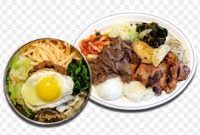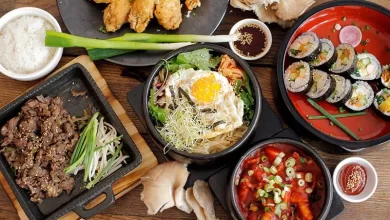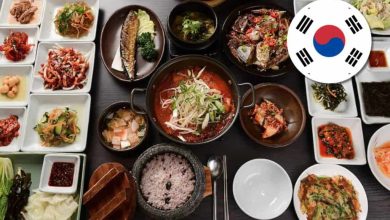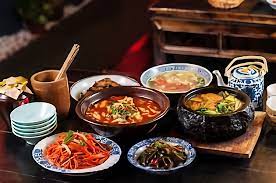Introduction:
Korean food has captured the attention of foodies all over the world with its strong tastes, variety of textures, and vivid colors. With a millennium of history at its core, Korean culinary customs have developed into a tasteful fusion of traditional methods and contemporary advancements. This essay takes the reader on a gourmet tour throughout the core of Korea, highlighting the essential components, national specialties, and cultural importance that make Korean cuisine so alluring and essential to the country’s identity.
Foundations of Korean Cuisine:
The diversity of the country’s terrain and climate—which includes mountains, plains, and a coastline—lays the groundwork for Korean food. The four main seasons—spring, summer, fall, and winter—have a significant impact on the kinds of foods that are customarily produced as well as the availability of resources.
- Rice and Staples: Considered the main grain of Korea, rice is an essential part of practically every meal. It is frequently served with a variety of “banchan,” or side dishes. These might provide a well-balanced and aesthetically pleasing meal, such as pickles, fermented veggies, and little servings of protein.
- Fermentation and Preservation: A fundamental component of Korean cooking methods is fermentation. The fermented vegetable dish known as kimchi is a common side dish for dinners. The technique of fermenting vegetables to preserve them adds distinct tastes and enhances the nutritional value of Korean food.
Key Ingredients in Korean Cuisine:
A unique combination of ingredients characterizes Korean cuisine, with each item adding to the cuisine’s rich and well-balanced tastes.
- Gochujang: A staple of Korean cuisine, gochujang is a fermented chili paste prepared from red chili peppers, glutinous rice, soybeans, and salt. Its rich, umami taste gives a range of foods richness and spiciness.
- Doenjang: Traditional Korean soybean paste called doenjang is used in marinades, stews, and soups. Its strong, savory flavor contributes significantly to the richness of tastes found in Korean food.
- Sesame Oil: In Korean cooking, sesame oil is a popular flavoring ingredient that gives food a deep, nutty flavor. It’s frequently drizzled on top of stir-fried veggies or rice as a final touch.
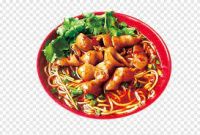
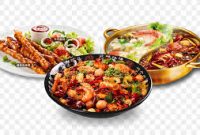
Iconic Korean Dishes:
- Kimchi: A mainstay of Korean cuisine, kimchi is a fermented meal usually made with Korean radishes and napa cabbage that is seasoned with chili pepper, garlic, ginger, and other aromatic spices. The outcome is a crunchy, tangy, and spicy side dish that goes well with a range of main dishes.
- Bibimbap: Bibimbap, which translates to “mixed rice,” is a vibrant and wholesome cuisine that consists of a bowl of steaming rice topped with gochujang, a fried egg, and a variety of seasoned veggies. The art of bibimbap is in the blending of the ingredients just before consumption, which results in a delicious fusion of textures and flavors.
Cultural Significance:
Korean food has a significant cultural impact on the country, affecting family get-togethers, holidays, and social conventions.
- Sharing and Communal Dining: Korean food is frequently served family-style, with an assortment of dishes for everyone to enjoy in the center of the table. The value of social and familial ties is emphasized by this communal meal arrangement.
- Seoul Food Culture: South Korea’s capital city of Seoul is a thriving center for cuisine culture. The city’s diverse culinary scene is enhanced by lively eateries, traditional teahouses, and street food markets. Seoul has a wide range of gastronomic experiences, from the hip Gangnam neighborhoods to the old Insadong streets.
Modern Innovations and Culinary Fusion:
Korea has welcomed worldwide influences and culinary advances while maintaining its rich culinary legacy, which has resulted in the creation of new dishes that combine history and modernity.
- Korean Barbecue Trends: Korean BBQ has become more popular across the world, with customers grilling meat at their tables. Creative takes on the traditional Korean BBQ, including cheese-filled bulgogi and inventive dipping sauces, demonstrate the culinary genre’s versatility and inventiveness.
- Fusion Cuisine: Modern restaurants and food carts alike are embracing the trend of Korean fusion cuisine, which blends traditional flavors with products and preparation methods from across the world. Modern Korean chefs have demonstrated their cross-cultural ingenuity with dishes such as bulgogi pizza and kimchi tacos.

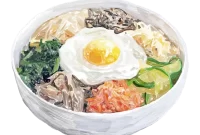
Conclusion:
In summary, Korean food is a culinary marvel that combines history, culture, and inventiveness on a plate to create something more than just nourishment. Every meal, from the rich depths of bulgogi to the sharp tang of kimchi, narrates a tale of tenacity, tradition, and the lasting spirit of a country. The rich tapestry of Korean cuisine continues to invite people to explore the subtle cultural elements and taste the lively flavors that make Korean cuisine an incredibly unique culinary experience, even as the country makes its imprint on the international culinary scene.
